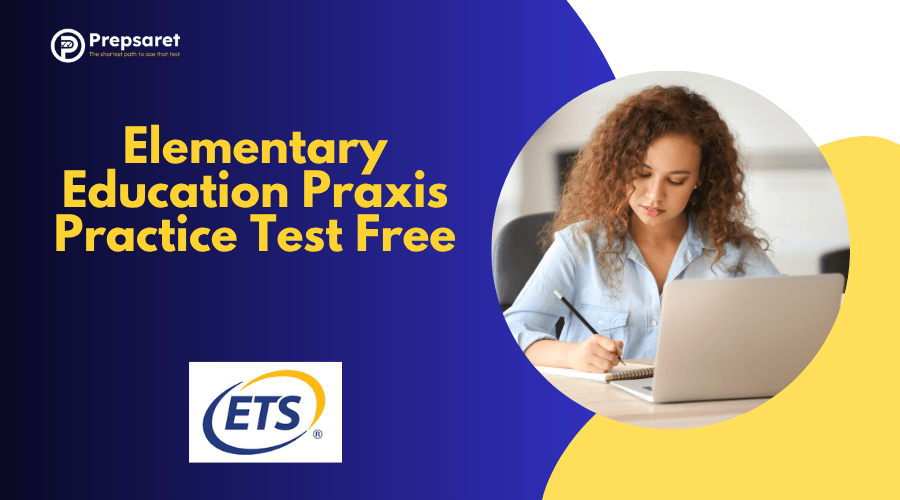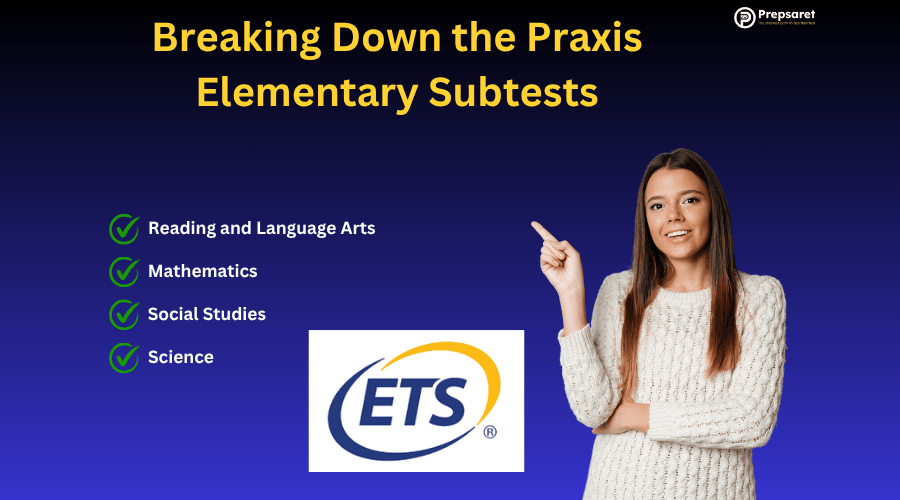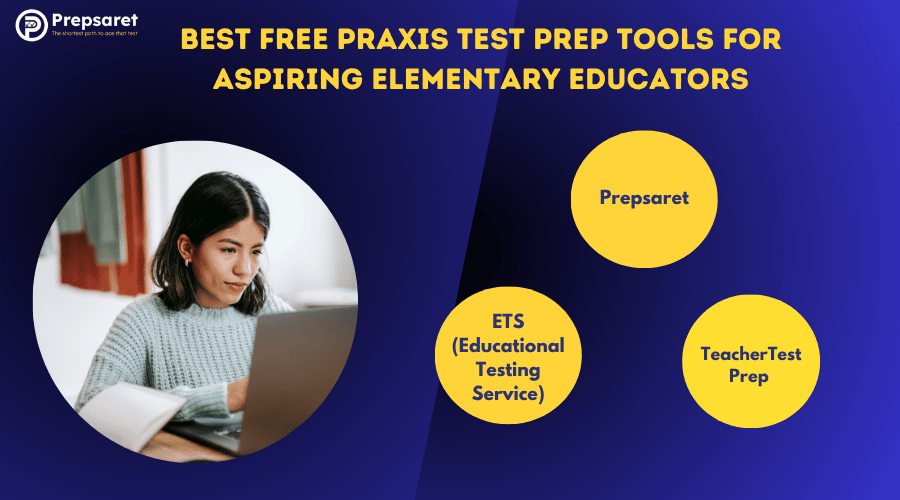If you’re dreaming of becoming a certified elementary school teacher, then chances are you’ve come across the Praxis 5001 test. And yes, it might look a little intimidating at first glance — but don’t worry. You’ve got this.
This test is a big deal because it helps prove you have the essential knowledge needed to lead a classroom full of energetic learners. Think of it like your teaching superhero cape — once you pass it, you’re ready to fly.
In this guide, we’re going to break down the Praxis 5001 in simple terms, explain why Prepsaret free practice tests are your new best friend, and help you find the best (and actually helpful.).
We will also cover free resources online — including PDFs you can download and study on the go, to help reinforce your knowledge.
What Is the Elementary Education Praxis 5001 Test and Why Is It Important?
The Praxis Elementary Education: Multiple Subjects (5001) test is part of the teacher certification process in many states.
It’s like a rite of passage for aspiring elementary educators. Before you can step into the classroom as a licensed teacher, most states want to be sure you know your stuff — and the 5001 is how they find out.
This test is made up of four separate subtests: Reading and Language Arts, Mathematics, Social Studies, and Science. They’re designed to check your knowledge in the very subjects you’ll be teaching every day. Basically, if you’re going to teach it, you’ve got to know it.
Passing the Praxis 5001 means you’re not just passionate about teaching — you’re qualified and ready. That’s huge, especially for parents, schools, and most importantly, your future students.
If you’re looking to prepare effectively, taking a Praxis practice test: Elementary Education version is one of the best strategies.
Not only do these tests give you a sense of what to expect, but you can often find an elementary education Praxis practice test free online or even a free Praxis 5001 practice test that aligns with your subject areas.
Related blog post: Praxis Core Practice Test
Breaking Down the Praxis Elementary Subtests: Reading, Math, Social Studies, and Science
Let’s talk about the big four — the subtests that make up the Praxis 5001:
- Reading and Language Arts: You’ll tackle reading comprehension, grammar, and how to help kids build strong literacy skills.
- Mathematics: Expect questions on numbers, algebraic thinking, and geometry — the kinds of math skills kids use from counting to measuring.
- Social Studies: This one dives into history, geography, civics, and economics. You’ll need to know how to make these subjects fun and meaningful.
- Science: Get ready for life science, physical science, and Earth science — with an emphasis on inquiry and experimentation.
Each subtest has its own time limit and number of questions. You’ll need about 3.5 to 4 hours to complete all four sections, depending on your pace.
The good news? Each subtest focuses on real teaching knowledge. So if you’ve been studying or you’ve got some teaching experience, you’re already on the right track. Use resources like Praxis practice test PDF files or a Praxis 5001 practice test Quizlet set to drill on each section individually.
Where to Find a Free Praxis Elementary Education Practice Test Online
Now here’s where it gets exciting — free practice tests are everywhere online… but not all are created equal.
Start with trusted educational websites like:
- ETS (yep, the official Praxis site)
- Khan Academy (great for brushing up on specific topics)
- Prepsaret
- 240 Tutoring
- Mometrix
These sites often include free Praxis practice test options, sample exams, and study tips. Some even give you feedback after you answer — just like a personal coach would. You can also find a free Praxis test for elementary education formatted to closely mimic the real experience.
Online tests are especially helpful because they mimic the real testing experience — same timing, same screen format, and instant results. But if you’re more of a pen-and-paper person, don’t worry. Printed tests are still super useful (and we’ll get to those in just a sec).
Free Praxis Practice Exam for Teachers: What’s Included?
So, what’s inside one of these magical free practice tests?
You’ll find:
- Multiple-choice questions just like the real exam
- Practice sections for each subtest
- Some even offer answer explanations to help you learn from mistakes
- A few include mini sample tests, while others give you full-length versions
If you’re using a free Elementary Praxis practice test, make sure it matches the current structure of the exam. Some teachers also benefit from combining multiple formats, such as online quizzes and printable Elementary Education Praxis practice test free PDF resources.
These practice exams help you build stamina, learn the pacing, and most importantly — reduce test-day anxiety. Practicing ahead of time = fewer surprises.
Read on: Praxis 5857 Practice Test
Downloadable Elementary Education Praxis Practice Test Free PDF Resources
Prefer to study offline or want to go screen-free for a bit? You’re not alone.
Here are a few reliable places to download free Praxis 5001 practice test PDFs:
- ETS.org offers sample questions in PDF form.
- Teachers Test Prep and Mometrix also include downloadable guides and practice sets.
- A quick search on your local library’s site might turn up resources, too.
You can easily find an Elementary Education Praxis practice test free online and print it, or directly download a Praxis practice test PDF to study at your convenience.
Offline PDFs are great because you can print them out, scribble notes, and take your time. Pro tip: organize them by subtest — create separate folders or binders for Reading, Math, Social Studies, and Science. That way, you’re not overwhelmed and can study bit by bit.
Praxis 5001 Study Guide PDF: What to Look for in a Quality Resource
When choosing a study guide PDF, here’s what to keep an eye out for:
- Objectives that match the current test outline (Praxis updates things occasionally.)
- Clear explanations with sample questions
- Practice questions WITH answers
- A format that’s easy to follow — no messy layouts or confusing charts
And here’s a friendly tip: skip anything that feels outdated or vague. If it doesn’t match the topics you’ll see on the real Praxis Elementary Education 5001 free practice test, it’s not worth your time.
Combine your study guide PDF with free Praxis practice test tools — whether you’re using Quizlet, printable resources, or online platforms — and you’ll create a smart study strategy that actually sticks.
Learn more: Praxis PLT 7–12 Practice Test
Best Free Praxis Test Prep Tools for Aspiring Elementary Educators
There are a variety of free online tools that can support different learning styles. Whether you like videos, interactive quizzes, or structured lessons, there’s something that fits your preference.
These are excellent additions to your toolkit of Elementary Education Praxis prep resources.
Prepsaret is an excellent choice for interactive video lessons, especially for math and science.
ETS, the official Praxis test provider, offers free study companions and Praxis test sample questions for each subtest. CrashCourse provides clear, fast-paced video content in social studies and science.
Teachers Test Prep also offers free diagnostic tests and sample questions, similar in format to a free Praxis practice exam for teachers. These can be helpful for identifying your strengths and weaknesses early in the study process.
Try using a mix of tools. Watch a video to understand a concept, then follow it up with questions from a different source.
This keeps your study sessions active and prevents boredom from setting in. Don’t forget to explore Free Praxis Elementary Subtest Practice sets tailored to each test domain to reinforce subject-specific knowledge.
Check this out: Best Praxis Study Resources
How to Create a Personalized Study Plan Using Free Praxis 5001 Tools
Now that you have access to solid resources, it’s time to turn those into a study plan that works for you.
Start by taking a diagnostic quiz to see where you currently stand. Based on those results, set some weekly goals. For example, you might decide to review two subtopics in math and one in science each week using both Free Praxis 5001 Practice Questions and your preferred Praxis 5001 study guide PDF.
Next, divide your study sessions by subtest. Monday might be for Reading & Language Arts, Tuesday for Math, and so on.
Using a free digital planner like Trello or a simple notebook can help you track what you’ve covered, especially if you’re rotating through Free Praxis Elementary Subtest Practice sets or a free Praxis practice exam for teachers.
Make sure your plan is flexible. If you feel confident in a subject earlier than expected, shift your focus to another area. And if you’re struggling with a section, give yourself more time to review it thoroughly using targeted Elementary Education Praxis prep resources.
Most importantly, monitor your progress. As you complete Praxis test sample questions or flashcards, keep a running log of your scores.
Over time, this will show your improvement and help you pinpoint any lingering weak spots before test day. Supplementing your efforts with a free teacher certification practice test every few weeks can further track your readiness.
Top Free Praxis 5001 Practice Questions for Each Subtest Area
The Praxis 5001 exam covers four big subject areas: Reading & Language Arts, Mathematics, Social Studies, and Science. Each subtest is scored separately, so it’s important to prep for all of them.
Reading & Language Arts (Subtest 5002)
Question:
Read the passage below and answer the question that follows:
“Maria stepped out onto the porch, the wind whipping her hair around her face. The sky, once a clear blue, had turned a threatening shade of gray. She gripped her coat tightly, bracing for what was to come.”
Which literary device is primarily used in the passage to build tension?
A. Simile
B. Hyperbole
C. Foreshadowing
D. Alliteration
Correct Answer: C. Foreshadowing
Explanation:Foreshadowing is a literary device that hints at future events. The passage creates a sense of unease and anticipation—Maria’s reaction to the changing weather and her nervous behavior suggest that something significant or ominous is about to happen. This builds tension in the reader.
- Simile compares two things using “like” or “as” (not present here).
- Hyperbole is exaggeration for effect.
- Alliteration is repetition of initial sounds (e.g., “whipping wind”), which appears slightly but is not the primary device used.
Mathematics (Subtest 5003)
Question: A rectangular garden measures 8 feet long and 5 feet wide. A path of uniform width is built inside the garden along all four edges, reducing the planting area. If the path is 1 foot wide, what is the area, in square feet, of the remaining planting space?
- 35
- 32
- 24
- 18
Correct Answer: D. 18
Explanation:
The original garden is a rectangle with:
- Length = 8 feet
- Width = 5 feet
- So the original area is:
8×5=40 square feet
The 1-foot-wide path is inside the garden, and it runs along all four sides. This reduces the usable length and width each by 2 feet total (1 foot per side):
- New length: 8−2 = 6 feet
- New width: 5−2=3 feet
- So, the remaining planting area is: 6×3=18 square feet
Social Studies (Subtest 5004)
Question: Which of the following best describes a system of checks and balances in the U.S. Constitution?
- The division of the federal government into executive, legislative, and judicial branches.
- The ability of each branch of government to limit the power of the others.
- The election process of representatives and senators.
- The power given to the states under the Tenth Amendment.
Correct Answer: B. The ability of each branch of government to limit the power of the others.
Explanation: Checks and balances are a foundational principle of the U.S. Constitution. Each branch (legislative, executive, judicial) can check the power of the others to ensure no single branch becomes too powerful.
- Option A describes separation of powers, which is related but distinct.
- Option C is about the electoral system.
- Option D describes federalism and state powers—not checks and balances.
Science (Subtest 5005)
Question: Which of the following best explains why Earth experiences different seasons?
- Earth’s distance from the sun changes throughout the year.
- Earth’s rotation on its axis every 24 hours.
- The moon’s gravitational pull on Earth’s oceans.
- The tilt of Earth’s axis relative to its orbit around the sun.
Correct Answer: D. The tilt of Earth’s axis relative to its orbit around the sun.
Explanation:
Earth is tilted at approximately 23.5 degrees. As Earth orbits the sun, different parts receive varying amounts of sunlight, causing seasons.
- A common misconception is that the Earth’s distance from the sun causes seasons (A), but this is incorrect—the orbit is nearly circular.
- Option B refers to day/night, not seasons.
- Option C relates to tides, not temperature or daylight changes.
Continue reading: Free Praxis Practice Test
Elementary Education Praxis Practice Test Free FAQs
How to Study for the Praxis Exam for Free?
To study for the Praxis exam for free, utilize online resources like official Praxis practice tests, educational websites, and free apps offering flashcards and quizzes.
Public libraries and university websites often provide free study guides. Joining study groups and watching instructional videos on platforms like YouTube can also enhance preparation without cost.
What Is the Best Way to Practice for the Praxis?
The best way to practice for the Praxis is by taking full-length, timed practice exams to simulate real test conditions.
Reviewing incorrect answers in detail helps identify knowledge gaps. Supplement practice tests with targeted study materials, flashcards, and content reviews to strengthen weak areas and build confidence.
What Is the Hardest Praxis Test to Pass?
The hardest Praxis test to pass varies by individual, but Praxis Physics and some specialized content exams are often considered toughest due to their advanced subject matter.
Additionally, the Praxis Principles of Learning and Teaching (PLT) can be difficult because it requires applying pedagogical knowledge to practical teaching scenarios.
How Common Is Failing Praxis?
Failing the Praxis is relatively uncommon but not rare. Approximately 10-15% of test takers fail on their first attempt, depending on the subject and state requirements.
Pass rates vary widely, with some content areas having higher failure rates due to the exam’s difficulty or candidate preparedness.
Can You Teach Without Passing the Praxis?
In most states, passing the Praxis is required for teacher certification, but some states offer alternative certification routes that do not mandate the Praxis exam.
These alternatives may include provisional licenses, emergency credentials, or other assessments, allowing candidates to teach temporarily while completing certification requirements.




